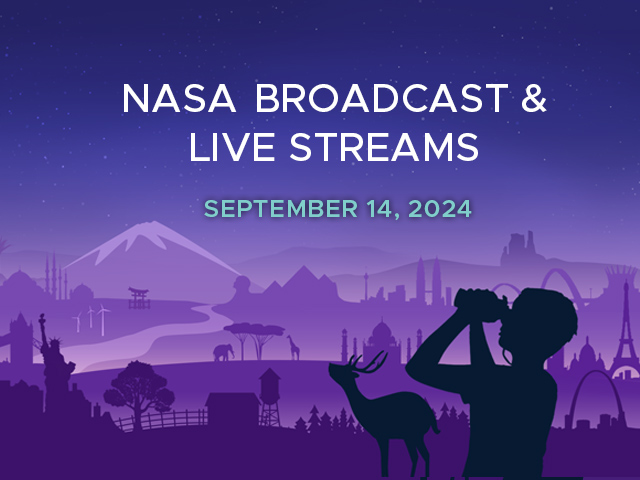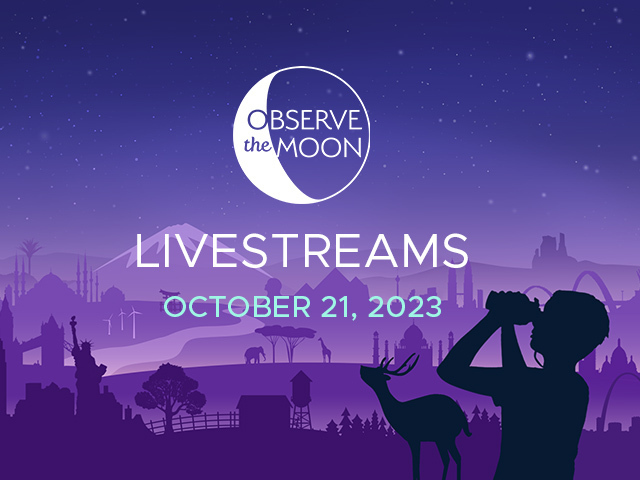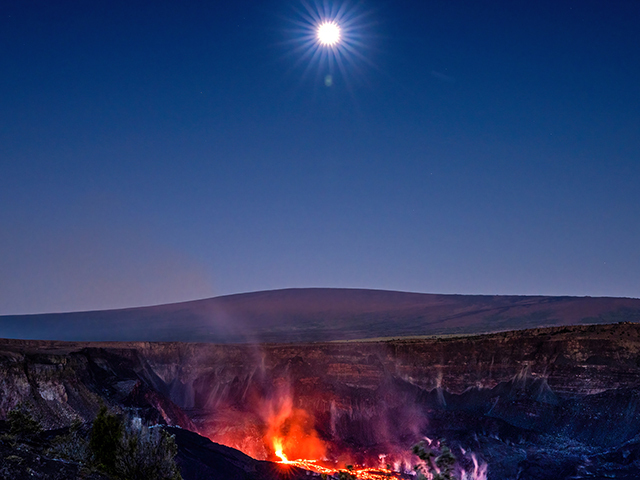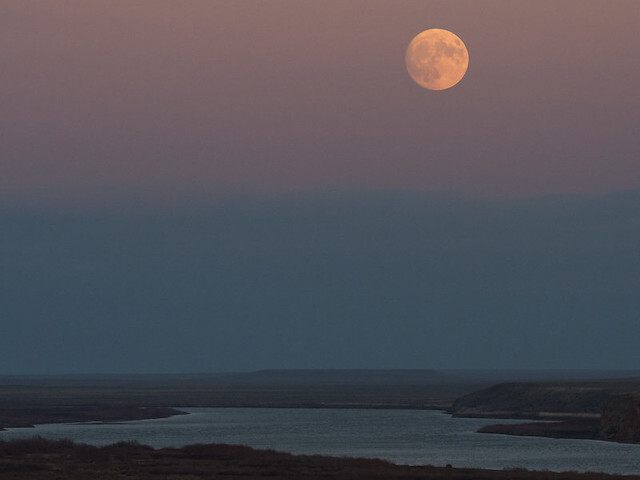News | July 20, 2018
Full Moon Blog: The Next Full Moon is the Sturgeon Moon, Hay Moon, Mead Moon, Green Corn Moon, Grain Moon, Buck Moon or Guru Purina
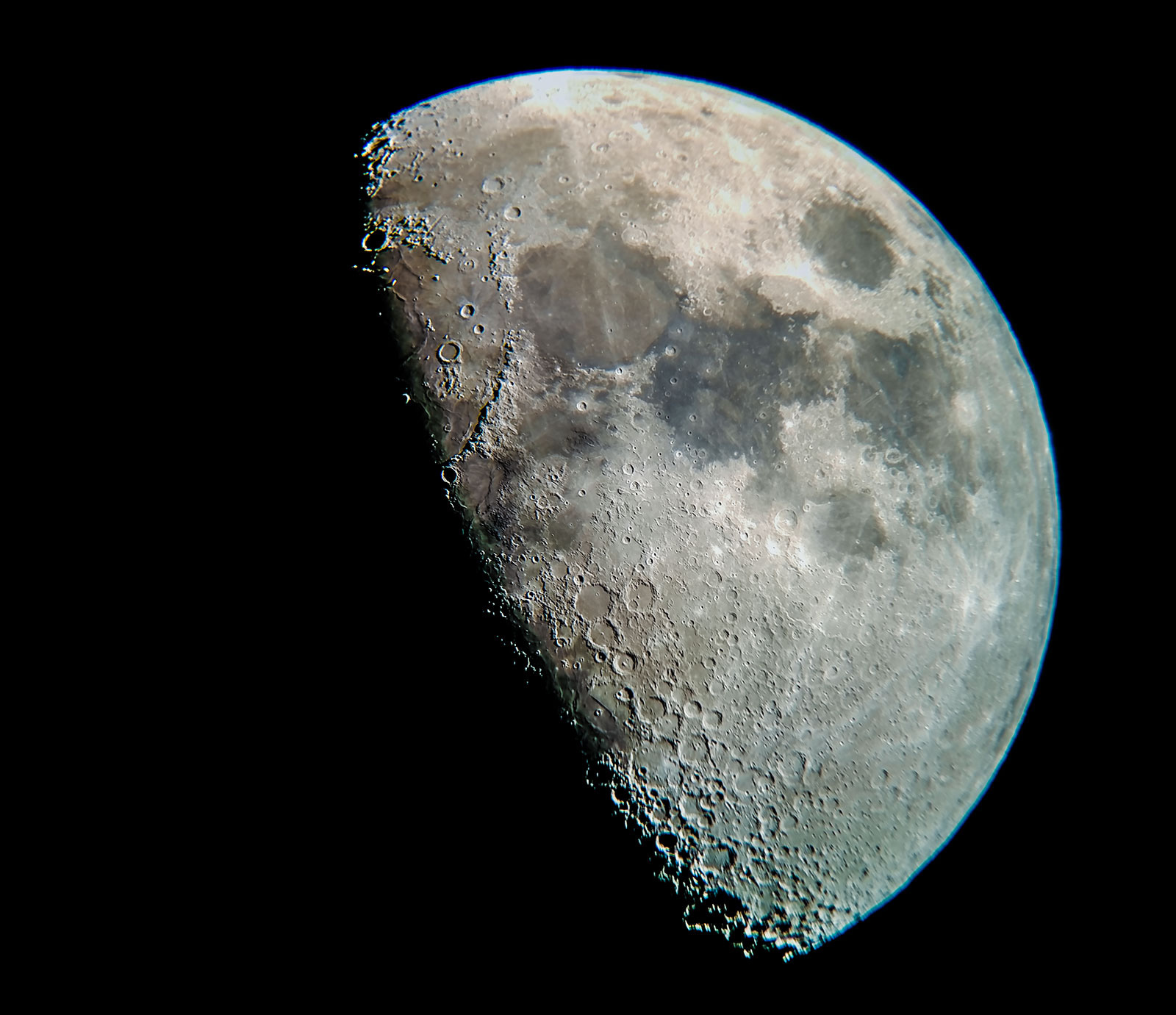
The lunar terminator—the divide between sunlight and darkness on the Moon—is sharp in this amateur photo of the Moon. The image was taken by Solar System Ambassador Thomas Campbell of College Station, Texas.
The next full Moon will be Friday afternoon, July 27, 2017, appearing "opposite" the Sun (in Earth-based longitude) at 4:20 PM EDT. The Moon will appear full for about three days centered around the this time, from Thursday morning through Sunday morning.
The Moon will be so close to opposite the Sun that it will pass through the shadow of the Earth, a total eclipse of the Moon. This eclipse will be visible from Europe, Africa, Asia, and Australia, and from parts of South America. It has become popular to call a lunar eclipse a "Blood Moon" because the light passing through the Earth's atmosphere and falling on the Moon can give it a reddish hue. More traditionally, the Blood Moon or the Sanguine Moon is the Hunter's Moon (usually in October), either because of the association with hunting, or because of the color of the leaves at that time of year. Since this total eclipse of the Moon will not be visible from North America, I will not say much more about it here (this Moon Missive is long enough as it is).
[[VIDEO.PLAYER||||Set to Claude Debussy's Clair de Lune, this visualization uses Lunar Reconnaissance Orbiter data to show the stark beauty of the Moon||||||||||||Column-width||336||false||false||false]]Traditional Names
A quick note about traditional Native American Moon names. The Maine Farmer's Almanac first published Indian names for the full Moons in the 1930's, and over time these names have become widely known and used. These names are attributed to the Algonquin tribes of what is now the northern and eastern United States. The Farmer's Almanac tied these names to the European months. I think it makes more sense that the Native American tribes tied their Moon names to the seasons rather than the European calendar. I expect that the Moon names may have varied by region, as (for example) when the strawberries ripened or the Sturgeons were abundant in the local area. This seems to match well with what I have been able to find out (so far) about traditional full Moon names from some of the neighbors of the Algonquins. In my Moon notes I tie the full Moon names to when it occurs in the season, other writers tie the names to the months of the calendar, and like a lot of traditions, there is no "right" answer.
The Sturgeon Moon
Most years, the second full Moon of Summer falls in early August, but this year it falls in late July. As the second full Moon of the summer season, this is the Sturgeon Moon, as sturgeon, a large fish of the Great Lakes and other major bodies of water, were more readily caught at this time of year. Since the second full Moon of summer usually falls in August, many call this the Buck Moon (because it is in July) and call the full Moon after next the Sturgeon Moon. This Moon was also called the Green Corn Moon or the Grain Moon. A few tribes called this the Red Moon because the rising Moon appears reddish through the sultry hazes of summer (a name related to the European "Rose Moon" for last month's Moon, the full Moon nearest the summer solstice).
Hay Moon
Europeans called July's full Moon the Hay Moon or the Mead Moon. Mead is created by fermenting honey mixed with water, sometimes adding fruits, spices, grains, or hops. Another name for this full Moon is the honeymoon. According to Wikipedia: "In ancient times honeymoon referred to the time of year when bee honey was ripe and cured to be harvested from hives or from the wild, which made it the sweetest time of the year." This was usually around the Summer solstice at the end of June. The tradition of calling the first month of marriage the "honeymoon" may be tied to the custom of marrying in June, that the "honeymoon" is the sweetest month of the year, or from the custom of serving mead at the wedding and giving the couple enough honey wine to last their first month as newlyweds.
Guru Full Moon
For Hindus this is the Guru Full Moon (Guru Purnima) and is celebrated as a time for clearing the mind and honoring the guru or spiritual master.
11th Moon
In lunisolar calendars the months change with the new Moon and full Moons fall in the middle of the lunar month. This full Moon is the middle of the sixth month of the Chinese calendar and Av in the Hebrew calendar. In the Islamic calendar the months start with the first sighting of the waxing crescent Moon a few days after the New Moon. This full Moon is near the middle of Dhu al-Qidah, the eleventh month of the calendar. Dhu al-Qidah is one of the four sacred months in Islam during which warfare is prohibited, hence the name "Master of Truce".
For Star Trek Fans
...and for Star Trek fans, a side note on the author Theodore Sturgeon. According to Wikipedia, Theodore Sturgeon wrote over 200 stories, mostly science fiction but some horror and mystery stories. He wrote several Star Trek scripts, two of which were produced. His Star Trek scripts introduced into the series "pon far," the Vulcan hand symbol, "live long and prosper," and (in a script that was not produced but that influenced later scripts) the "Prime Directive."
As usual, the wearing of suitably celebratory celestial attire is encouraged in honor of the full Moon. In addition, take a moment to clear your mind, perhaps you should consider reading some Theodore Sturgeon, and please, no fighting...
July 27
As Summer continues towards Fall, the daily periods of sunlight continue to shorten. For the Washington, DC area, on the day of the full Moon on July 27, morning twilight will begin at 4:58 AM, sunrise will be at 6:05 AM, the Sun will reach a maximum altitude of 70.2 degrees at 1:15 PM, sunset will be at 8:24 PM, and evening twilight will end at 9:31 PM EDT. By the day of the full Moon on August 26, morning twilight will begin at 5:31 AM, sunrise will be at 6:32 AM, the Sun will reach a maximum altitude of 61.4 degrees at 1:10 PM, sunset will be at 7:47 PM, and evening twilight will end at 8:48 PM EDT.
On the evening of the July full Moon, the planet Mercury will be difficult to see in the glow of dusk, setting about 30 minutes after sunset. As evening twilight ends (at 9:31 PM EDT for the Washington, DC area), Mercury will have already set. The brightest of the planets, Venus, will appear in the west (10 degrees above the horizon). When Venus is visible in the evening, it is known as Hesperus, Vesper, or the Evening Star. Temporarily the second brightest planet in the sky, Mars, will appear in the southeast (about 7 degrees above the horizon for the DC area). Mars will be at its closest and brightest in late July. Mars is currently in the middle of a planet-wide dust storm, masking its surface features even with the biggest telescopes we have on Earth. Currently the third bright planet, Jupiter, will appear high in the southwest (29 degrees above the horizon for the DC area). Jupiter was at its closest and brightest for the year in May, and remains bright. The bright planet Saturn will appear in the south-southeast (25 degrees above the horizon for the DC area). Saturn was at its closest and brightest for the year in late June.
The "Summer Triangle"
The "Summer Triangle" will be high in the east. The "Summer Triangle" is not a constellation but consists of three bright stars from three different constellations. Looking east, high in the upper middle is Vega, the brightest star in the constellation Lyra the Harp; to the left is Deneb, the brightest star in the constellation Cygnus the Swan; and to the lower right is Altair, the brightest star in the constellation Aquila the Eagle. If you are one of the estimated 20% of Americans who live in a place dark enough to see our home galaxy, the Milky Way, you will be able to see this band of light stretching from the south to the north-northeast, with Deneb on the Milky Way and Altair and Vega on opposite sides of this band of light. These bright stars and the Milky Way play a role in Asian legends. There are many variations of the story, but basically, the bright star Vega symbolizes the weaver girl and the bright star Altair symbolizes the cowherd. They fall in love and neglect their duties, so the Goddess of Heaven puts a wide river in the sky, the Milky Way, to keep them apart. They are allowed to meet only one night a year, on the seventh night of the seventh month (around the time of the first quarter Moon), when the bright star Deneb forms a bridge across the Milky Way. The seventh night of the seventh month is known as the double seventh festival, Qixi in China, Chilseok in Korea, and Thất Tịch in Vietnam. The Japanese Tanabata or the Star Festival is related, but is no longer tied to the lunisolar date.
As the month progresses the stars, along with Jupiter, Saturn, and Mars, will appear to shift more towards the west, while Venus will appear to shift along the horizon from the west more towards the west-southwest. By the evening of the late August full Moon, Venus will appear in the west-southwest about 6 degrees above the horizon, Jupiter will appear in the southwest about 20 degrees above the horizon, Saturn in the south about 28 degrees above the horizon, and Mars in the south-southeast about 18 degrees above the horizon. The Summer Triangle will have shifted higher in the east, with Vega appearing nearly overhead.
In the morning on the night of the full Moon at the end of July, as morning twilight begins (at 4:57 AM EDT for the Washington, DC area), Mars will appear low in the southwest (about 8 degrees above the horizon for the DC area). The bright stars of the Summer Triangle will appear high in the west. As the month progresses, the stars and Mars will appear to shift towards the west, with Mars setting before morning twilight begins after the first week in August. By mid-August the planet Mercury will begin to emerge from the glow of dawn in the east-northeast about 30 minutes before sunrise. Mercury will appear at its highest above the horizon at the time morning twilight begins at the end of August.
More Planet Watching
This summer should be a great time for planet watching, especially with a backyard telescope. Jupiter was at its closest and brightest for the year on May 8 2018, Saturn was at its closest and brightest on June 27, 2018, and Mars will be at its closest and brightest at the end of July, 2018. Jupiter, Saturn, and Mars will appear to shift towards the west over the coming months, making them visible earlier in the evening sky (more suitable for sky watching with small children with earlier bedtimes). In the west, the brightest of the planets, Venus, will also grow slowly in brightness, reaching its greatest brilliance in late September 2018. With a small telescope you should be able to see Jupiter's four bright moons, Ganymede, Callisto, Europa, and Io, shifting positions noticeably in the course of an evening. Galileo was the first person known to point the newly developed telescope at Jupiter, and he immediately noticed these moons that we now call the Galilean moons. For Saturn, you should be able to see the brightly illuminated rings as well as the motions of Saturn's moons, particularly the large moon, Titan, which has an atmosphere and lakes of liquid methane. Venus will appear gibbous, about three-fourths full, and will gradually become brighter but less full as it shifts closer to Earth, appearing half-full in August 2018.
The Perseid Meteor Shower should be one of the best meteor showers of the year. The Perseids should be active from July 13 to August 29, peaking after midnight the morning of Monday, August 13. With the new Moon on August 11 this year, moonlight will not interfere with viewing the peak. According to the "Fluxtimator" (see URL https://leonid.arc.nasa.gov/estimator.html), if we have clear skies and a clear view of the sky, for our urban Washington, DC area, we should be able to see about 8 meteors per hour at around 4 AM. If we get away from the city lights and into the countryside, the estimate goes up to about 70 per hour. The Perseid meteors are caused by dust from the comet 109P/Swift-Tuttle that enters our atmosphere at 58 kilometers per second (130,000 miles per hour).
Friday evening into Saturday morning, July 20 to 21, 2018, the bright planet Jupiter will appear about 4 degrees below the waxing gibbous Moon. For the Washington, DC area, evening twilight will end at 9:38 PM EDT, Jupiter will set Saturday morning at 1:11 AM, and the Moon will set 20 minutes later.
Even though they are not visible usually, I include in these Moon missives information about Near Earth Objects (mostly asteroids) that pass the Earth within about 10 lunar distances, because I find it interesting that we have discovered so many. On Saturday morning, July 21, 2018 at 7:09 AM EDT, Near Earth Object (2018 NE1), between 58 and 130 meters (191 to 427 feet) in diameter, will pass the Earth at between 10.0 and 10.1 lunar distances (nominally 10.1), traveling at 14.22 kilometers per second (31,807 miles per hour). At 9:24 AM EDT, Near Earth Object (2018 NF4), between 84 and 188 meters (276 to 617 feet) in diameter, will pass the Earth at between 18.6 and 18.9 lunar distances (nominally 18.8), traveling at 12.76 kilometers per second (28,532 miles per hour). On Sunday morning, July 22, 2018 at 12:11 AM EDT, Near Earth Object (2018 OL), between 44 and 99 meters (145 to 324 feet) in diameter, will pass the Earth at between 11.4 and 11.5 lunar distances (nominally 11.4), traveling at 16.07 kilometers per second (35,954 miles per hour).
Tuesday evening into Wednesday morning, July 24 to 25, 2018, the bright planet Saturn will appear near the waxing gibbous Moon. For the Washington, DC area, evening twilight will end at 9:34 PM EDT, the Moon will reach its highest in the sky at 11:08 PM, Saturn will set Wednesday morning at 3:58 AM, and the Moon will set 9 minutes later.
On Thursday evening July 26, 2018 at 9:23 PM EDT, Near Earth Object (2018 NR1), between 28 and 62 meters (91 to 204 feet) in diameter, will pass the Earth at between 16.9 and 17.1 lunar distances (nominally 17.0), traveling at 5.14 kilometers per second (11,503 miles per hour).
Friday morning, July 27, 2018, the planet Mars will be at opposition, or opposite the Sun as seen from the Earth, effectively a "full" Mars that rises around sunset and sets around sunrise. Since the orbits of the Earth and Mars are elliptical rather than perfect circles, Mars will be at its closest to Earth a few days after opposition, on July 31, 2018.
Friday morning, July 27, 2018, at 1:44 AM EDT, the Moon will be at apogee, its farthest from the Earth for this orbit.
As mentioned above, the next full Moon will be on Friday afternoon, July 27, 2018, at 4:20 PM EDT. This will be a total eclipse of the Moon, but the eclipse will not be visible from nearly all of North America.
Friday evening, July 27, 2018, the bright planet Mars, nearly at its brightest for this apparition, will appear 7 to 8 degrees to the lower right of the full Moon. Currently, Mars is in the midst of a planet-wide dust storm, so if you looked at Mars with a large enough telescope, you would see that the usual markings are hidden. Years ago, before we sent spacecraft to look at Mars close up (starting with Mariner 4 in 1964), astronomers would see the features on Mars changing with the seasons, causing them to theorize they were seeing signs of life, a growing season on Mars. This inspired authors to write about life on Mars in books such as War of the Worlds (1897) and the Martian Chronicles (1950). We now understand that what astronomers were seeing were changes in the appears of Mars due to dust storms and season clouds.
July 31
On Tuesday Morning, July 31, 2018, at about 4 AM EDT, Mars will be at its closest to Earth for this apparition.
August 4
Saturday, August 4, 2018, the waning Moon will appear half-full as it reaches its last quarter at 2:18 PM EDT.
August 6
Monday morning, August 6, 2018, the bright star Aldebaran will appear near the waning crescent Moon. For the Washington, DC area, the Moon will rise in the east-northeast around 1:21 AM and Aldebaran will rise to the lower left of the Moon about 26 minutes later. They will appear to shift closer together until Aldebaran is lost in the glow of dawn, with morning twilight beginning at 5:09 AM EDT.
August 7
Tuesday morning, August 7, the Moon will appear to have shifted to the other side of Aldebaran. For the Washington, DC area, Aldebaran will rise around 1:43 AM and the waning crescent Moon will rise at 2:07 AM EDT. Aldebaran and the Moon will appear to drift apart until lost in the glow of dawn.
August 8
Wednesday night, August 8, 2018, is when Mercury will pass between the Earth and the Sun, called Inferior Conjunction. Later in August Mercury will begin to emerge from the glow of the Sun in the morning sky.
August 10
Friday afternoon, August 10, 2018, at 2:05 PM EDT, the Moon will be at perigee, its closest to the Earth for this orbit.
August 11
Saturday morning, August 11, 2018, at 5:58 AM EDT, will be the new Moon, when the Moon passes between the Earth and the Sun and is usually not visible from the Earth. The Moon will be visible from northern Europe or northeastern Asia, as it will block part of the Sun in a partial eclipse. Remember, do not look directly at the Sun without eclipse glasses.
In most lunisolar calendars the new month starts with the New Moon. In the Hebrew calendar days start with sunset, so Saturday evening marks the start of Elul in the Hebrew calendar. In the traditional Chinese calendar days begin at midnight and the day of the New Moon is the first day of the new month, so this is the start of the seventh month in the Chinese calendar.
August 12
In the Islamic calendar the months start with the first sighting of the waxing crescent Moon after the New Moon. Monday evening, August 12, 2018, should mark the beginning of Dhu al-Hijjah, the twelfth and final month of the Islamic year, a sacred month, the month of the Hajj. Making the Hajj or pilgrimage to Mecca at least once in your life is one of the Five Pillars of Islam. For more information on the events during the month of the Hajj, see for example https://en.wikipedia.org/wiki/Dhu_al-Hijjah
August 13
Early Monday morning, August 13, 2018, will be the peak of the annual Perseid Meteor shower. With the new Moon on August 11 this year, moonlight will not interfere with viewing these meteors. The best time to look for meteors is after midnight but before any sign of dawn (nautical twilight begins at 5:17 AM EDT for the Washington, DC area). Ideally, you should be far away from city lights, in a very dark location, with a clear view of a large area of sky, with no clouds or haze. Even a thin haze, barely visible, can reflect back nearby city lights and reduce your visibility. It can take your eyes 30 minutes or so to completely adapt to the dark, so no checking your smart phone between meteor watches. If it seems like you are seeing more meteors out of the corner of your eye, it could be because that part of your eye is more sensitive to light (and less sensitive to color) that the center of your field of view.
According to the "Fluxtimator" (see URL https://leonid.arc.nasa.gov/estimator.html), if we have clear skies and a clear view of the sky, for our urban Washington, DC area, we should be able to see about 8 meteors per hour between 4 and 5 AM EDT. If we get away from the city lights and into the countryside, the estimate goes up to about 70 per hour. The Perseid meteors are caused by dust from the comet 109P/Swift-Tuttle that enters our atmosphere at 58 kilometers per second (130,000 miles per hour).
August 14
On Tuesday evening, August 14, 2018, the bright planet Venus will appear in the west about 6 degrees below the waxing crescent Moon. For the Washington, DC area, evening twilight will end a 9:07 PM EDT, with Venus about 8 degrees above the horizon and the Moon about 14 degrees above the horizon. Venus will set at 9:51 PM and the Moon will set at 10:26 PM.
August 15
On Wednesday evening, August 15, 2018, the bright star Spica will appear in the west-southwest about 7 degrees below the waxing crescent Moon.
August 16
On Thursday evening, August 16, 2018, the bright planet Jupiter will appear in the southwest about 8 degrees to the left of the waxing crescent Moon.
August 17
Friday, August 17, 2018, will be when the bright planet Venus is at its greatest angular separation to the east from the Sun as seen from the Earth, called Greatest Eastern Elongation. Because of Earth's tilt relative to the path of the planets around the Sun (which causes our seasons), this is not the same date as when Venus is highest in the sky at the time evening twilight begins (that occurred back in early June).
August 17
On Friday evening, August 17, 2018, the Moon will appear to have shifted such that the bright planet Jupiter appears in the southwest to the lower right of the Moon.
Friday, August 17, 2018, will be the seventh day of the seventh month of the Chinese calendar, sometimes called the Chinese Valentine's Day. The seventh night of the seventh month is known as the double seventh festival, Qixi in China, Chilseok in Korea, and Thất Tịch in Vietnam. There are many variations on the legend, but basically, the bright star Vega symbolizes the weaver girl and the bright star Altair symbolizes the cowherd. They fall in love and neglect their duties, so the Goddess of Heaven puts a wide river in the sky, the Milky Way, to keep them apart. They are allowed to meet only one night a year, on the seventh night of the seventh month, when the bright star Deneb forms a bridge across the Milky Way. In some versions of the legend, the bridge is formed by magpies, so this is sometimes called the Magpie Festival. The Japanese Tanabata or the Star Festival is related, but is no longer tied to the lunisolar date (it is now celebrated on July 7th, the double sevenths in the Gregorian Calendar). For more information see for example https://en.wikipedia.org/wiki/Qixi_Festival
August 18
On Saturday morning, August 18, 2018, the Moon will appear half-full as it reaches its first quarter at 3:49 AM EDT.
August 20 to 21
Monday evening into Tuesday morning, August 20 to 21, 2018, the bright planet Saturn will appear near the waxing gibbous Moon. Saturn will appear in the south to the lower left of the Moon as evening twilight ends, and they will appear to shift closer together until moonset (at around 2:04 AM EDT for the Washington, DC area).
August 22 to 23
On Wednesday night into Thursday morning, August 22 to 23, 2018, the bright planet Mars will appear below the waxing gibbous Moon. Mars will appear to shift more to the left of the Moon until they set together (at 3:40 AM EDT for the Washington, DC area).
Thursday morning, August 23, 2018, at 7:23 AM EDT, the Moon will be at apogee, its farthest from the Earth for this orbit.
Thursday evening, August 23, 2018, the Moon will appear to have shifted such that the bright planet Mars will appear to the lower right of the Moon. Mars will set Friday morning (at 3:36 AM EDT for the Washington DC area) and the Moon will set (at 4:45 AM).
August 26
The full Moon after next will be on Sunday morning, August 26, 2018, at 7:56 AM EDT.


